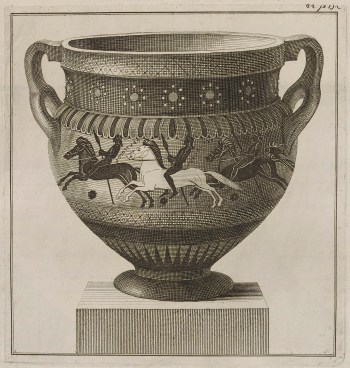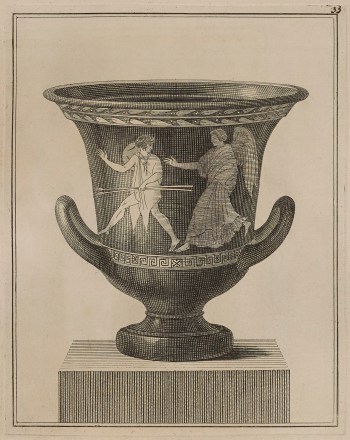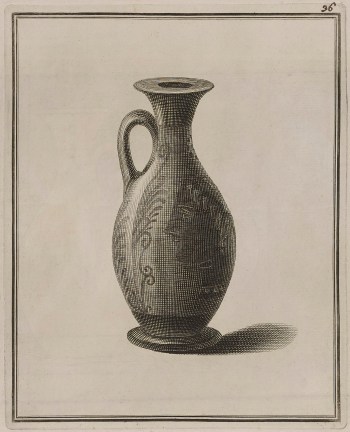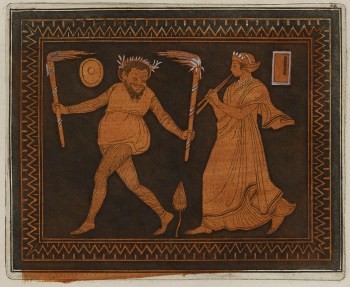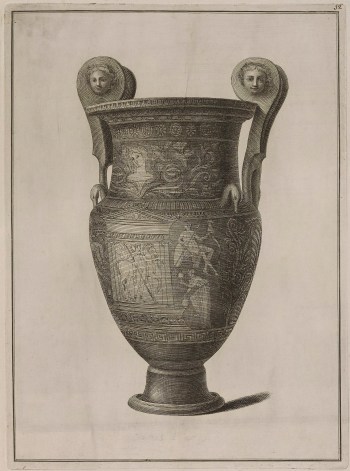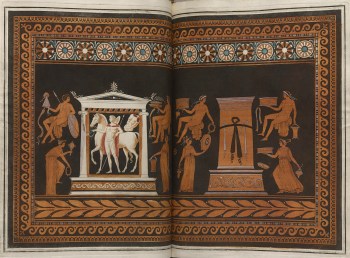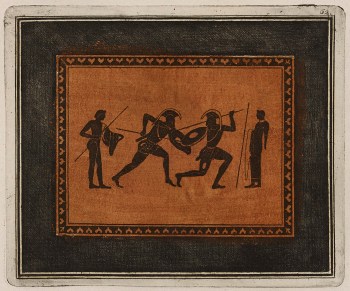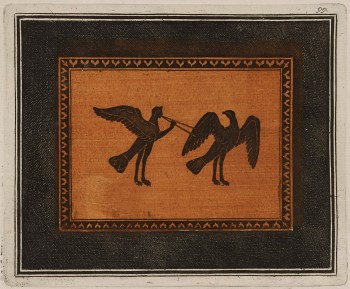Collection Of Etruscan, Greek, And Roman Antiquities From The Cabinet Of The Honble. Wm. Hamilton His Britannick Maiesty's Envoy Extraordinary At The Court Of Naples.
RA Collection: Book
Record number
Variant Title
Imprint
Physical Description
General Note
Contents
Responsibility Note
Most in-text illustrations in both volumes are signed by draughtsman (Giuseppe Bracci or Edmondo Beaulieu) and/or engraver (Ant. Cardon, Car. Nolli, Carmine Pignatari, Filip. de Grado). The illustration of the Trebbia tomb (v.II. p.57) is said by Winckelmann to have been based on a sketch made by Hamilton himself.
The printer is named in the colophons of Vols. I, II: 'Imprimé a Naples - Par François Morelli'.
Volume I is dedicated by William Hamilton to King George III. Volume II has two dedication-plates - one by D'Hancarville to the memory of J.J. Winckelmann, the other to 'Sodalibus Amor Patr. Congreg In Augmentum Agric. Commercii Et. Bonar. Art. Mag. Britanniae' [i.e. the Society for the Encouragement of Arts, Manufactures, and Commerce].
References
G. Ceserani and A. Milanese, edd., Antiquarianism, museums and cultural heritage. Collecting and its contexts in eighteenth-century Naples, = Journal of the History of Collections, 19:2 (2007) [complete issue]; L. Burn, 'Sir William Hamilton and the Greekness of Greek vases', in Journal of the history of collections, 9:2 (1997), p.241-52; I. Jenkins and K. Sloan, Vases & Volcanoes Sir William Hamilton And His Collection [exhibition catalogue] (1996); M. Vickers, 'Value and simplicity', in M. Vickers and D. Gill, Artful crafts: ancient Greek silverware and pottery (1994); D. Constantine, 'Winckelmann and William Hamilton', in Oxford German Studies, 22 (1993), p.55-83; P. Griener, Le Antichità Etrusche, Greche e Romane 1766-1776 di Pierre Hugues d'Hancarville: la pubblicazione delle ceramiche antiche della prima collezione Hamilton (1992); C.L. Lyons, 'The Neapolitan context of Hamilton's antiquities collection', in Journal of the history of collections, 4 (1992), p.1-26, and 9:2 (1997), p.229-39; N. Ramage, 'The dating of the four volumes of Sir William Hamilton', in Ars ceramica, 8 (1991), p.35; F. Bologna, 'The rediscovery of Herculaneum and Pompeii in the artistic culture of Europe in the eighteenth century', in B. Contello, ed., Rediscovering Pompeii [exhibition catalogue] (1990), p.79-91; N. Ramage, 'Wedgwood and Sir William Hamilton', in Proceedings of the thirty-fifth annual Wedgwood international seminar (1990), p.71-90; N. Ramage, 'Owed to a Grecian urn: the debt of Flaxman and Wedgwood to Hamilton', in Ars ceramica, 6 (1989), p. 8-12; A. Schnapp, 'La pratique de la collection ... chevalier d'Hancarville', in L'anticomanie (1992), p.209-18; N. Ramage, 'The initial letters in Sir William Hamilton's collection of Antiquities', in Burlington magazine, 129 (1987 July), p.446-56; F. Haskell, 'The Baron d'Hancarville', in Past and Present in Art (1987).
Summary Note
The title-plates of Volumes II-IV have the words 'And Plenipotentiary' after 'Envoy Extraordinary', and Volume II continues with the words 'Vol. Second'. Each volume has a parallel French title-plate, which reads, 'Antiquités Etrusques, Grecques Et Romaines, Tirées Du Cabinet De M. Hamilton, Envoyé Extraordinaire De S.M. Britannique En Cours De Naples' (Vols. II-IV with 'Et Plenipotentiaire' after 'Extraordinaire', and Vol. II. continuing 'Tome Second').
The text of Volumes I, II, is given in English and French in parallel; that of Volumes III, IV, in French only. The dedications of Vols. I, II, are in Latin; the imprimaturs in Vol. I, in Italian and Latin.
This four-volume publication combines vivid and influential images with speculation on the development of ancient art. William Hamilton collected modern pictures and antiquities. Here his 'Antiquities' are almost all vases - described on the title-plates as 'Etruscan, Greek, And Roman' but known to be Greek, whether from south Italy ('Magna Graecia') or the Greek mainland. Both Hamilton and Hancarville (to whom Hamilton entrusted the preparation of the text) regarded this large collection of vases as providing not only 'exquisite Models' but also a possible basis for tracing the 'progress of Painting and Design' and the 'stiles of the different periods in the Art of the Ancients' (v.I., p. vi, 168). For this reason, although Explanations of the plates are included in Vols. I, II, and the text of Vol. II includes a Discourse Upon Painting and a chapter on the Uses the Ancients made of their Vases, How they are found, and the manner of painting them, Hancarville allows his speculations to range very widely, including in Volume I a history of the Etruscans, their letters and customs and the Tuscan order, and in Vols. III, IV, a history of Greek sculpture to the death of Alexander. Here he adumbrates ideas later expounded in his Recherches sur l'origine, l'esprit et les progres des arts (1785-6), tracing the oscillation in art between concentrated symbol and explicit, sophisticated representation.
The plates generally show vase paintings of myths or social subjects, with views of the vases and detailed measurements. One mythological painting shows a nude Silenus - overpainted as clothed by its previous owner, Passeri (vol. II. pl. 68; cf. G.B.Passeri, Picturae Etruscorum In Vasculis, II, pl.103). An example of a social subject is pl. 74 of vol. II, representing a symposium. An interesting in-text illustration shows a group of vases newly discovered in a tomb (vol. II, p.57). Many plates are coloured by hand (in Vol. I 46 plates; in Vol. II 53 plates).
The images were most notably taken up by Josiah Wedgwood, one of whose first-day vases made at his new pottery, 'Etruria', in 1769 carries a design based on plate 129 of Vol. I, and who also reproduced the vase shown in the dedication-plate of Vol.I. Whole rooms drew on these images for their decoration (as at Newtimber Place, Sussex, and Bowood, Wiltshire); and they played a considerable part in fostering the Neoclassical taste for outline drawing and engraving.
In 1772 Hamilton's first collection of vases and antiquities was bought for the British Museum, where one red-figure volute crater is known as the 'Hamilton Vase' (shown in Vol. I. pl. 52-6). For many years Hamilton made gifts to the Royal Academy, including casts of bas-reliefs and Piranesi's prints of the 'Warwick' vase, but oddly did not donate a copy of this work. Although (unsurprisingly) John Flaxman included it in a list of desiderata of 'Books essentially useful in the Arts' that the RA Council resolved to purchase at a meeting on 23 October 1801 (Council Minutes III, 113-14), there is no evidence of a copy having entered the RA Library until the present incomplete set arrived on 6 August 1835 as part of Prince Hoare's bequest to the Academy of books and prints from his library in London (see RA Council Minutes VIII, 123-25).
Provenance
Copy Note
Binding Note
Name as Subject
Subject
Vases, Greek - Italy - Campania - History
Collections - British - Italy - Campania - Naples - History - 18th century
Art history - Catalogues - Pattern books - Italy - 18th century
Pictorial works - Hand coloring - Italy - 18th century
Contributors
Pierre Francois Hugues, baron d' Hancarville
George III King of Great Britain, dedicatee
Prince Hoare, previous owner, donor
Giuseppe Bracci, draughtsman
Antoine Alexandre Joseph Cardon, engraver
Carlo Nolli, engraver
Carmine Pignatari, engraver
Filippo de Grado, engraver
Edmondo Beaulieu, draughtsman
Images from this book
48 results
-
![Sir William Hamilton, Dedication to King George III]()
Sir William Hamilton
Dedication to King George III
-
![Sir William Hamilton, Colour plate of Apollo, Eros and the Muses at their toilet, from attic hydria]()
Sir William Hamilton
Colour plate of Apollo, Eros and the Muses at their toilet, from attic hydria
Etching with hand colouring and highlights in white lead
-
![Sir William Hamilton, Outline and profile of attic kalyx krater]()
Sir William Hamilton
Outline and profile of attic kalyx krater
-
![Sir William Hamilton, Preface]()
Sir William Hamilton
Preface
-
![Sir William Hamilton, Preface]()
Sir William Hamilton
Preface
-
![Sir William Hamilton, Title-page]()
Sir William Hamilton
Title-page
-
![Sir William Hamilton, Title page]()
Sir William Hamilton
Title page
-
![Sir William Hamilton, Of the Origin of the Etruscans, and of their Letters]()
Sir William Hamilton
Of the Origin of the Etruscans, and of their Letters
-
![Sir William Hamilton, Of the Origin of the Etruscans, and of their Letters]()
Sir William Hamilton
Of the Origin of the Etruscans, and of their Letters
-
![Sir William Hamilton, Of Architecutre, Antiquity of the Tuscan Order]()
Sir William Hamilton
Of Architecutre, Antiquity of the Tuscan Order
-
![Sir William Hamilton, Of Architecture, Antiquity of the Tuscan Order]()
Sir William Hamilton
Of Architecture, Antiquity of the Tuscan Order
-
![Sir William Hamilton, Of Sculpture and Painting]()
Sir William Hamilton
Of Sculpture and Painting
-
![Sir William Hamilton, Of Sculpture and Painting]()
Sir William Hamilton
Of Sculpture and Painting
-
![Sir William Hamilton, The Hunt Krater: detailed view showing three galloping horsemen]()
Sir William Hamilton
The Hunt Krater: detailed view showing three galloping horsemen
-
![Sir William Hamilton, The Hunt Krater: outlined view and profile]()
Sir William Hamilton
The Hunt Krater: outlined view and profile
-
![Sir William Hamilton, The Hunt Krater: colour plate of boar hunt with five hunters]()
Sir William Hamilton
The Hunt Krater: colour plate of boar hunt with five hunters
-
![Sir William Hamilton, The Hunt Krater: coloured plate showing three galloping horsemen]()
Sir William Hamilton
The Hunt Krater: coloured plate showing three galloping horsemen
-
![Sir William Hamilton, Colour plate of attic hydria showing two women playing ball]()
Sir William Hamilton
Colour plate of attic hydria showing two women playing ball
-
![Sir William Hamilton, Lucanian bell krater (left) and attic hydria (right)]()
Sir William Hamilton
Lucanian bell krater (left) and attic hydria (right)
-
![Sir William Hamilton, Attic hydria showing Apollo, Eros and the Muses at their toilet]()
Sir William Hamilton
Attic hydria showing Apollo, Eros and the Muses at their toilet
-
![Sir William Hamilton, Outline and profile view of attic hydria]()
Sir William Hamilton
Outline and profile view of attic hydria
-
![Sir William Hamilton, Attic kalyx krater showing Eos pursuing Kephalos]()
Sir William Hamilton
Attic kalyx krater showing Eos pursuing Kephalos
-
![Sir William Hamilton, Colour plate of Eos pursuing Kephalos, from attic kalyx krater]()
Sir William Hamilton
Colour plate of Eos pursuing Kephalos, from attic kalyx krater
Etching with hand colouring
-
![Sir William Hamilton, Campanian black figured lekythos showing woman's head]()
Sir William Hamilton
Campanian black figured lekythos showing woman's head
-
![Sir William Hamilton, Outline and profile of campanian black figured lekythos]()
Sir William Hamilton
Outline and profile of campanian black figured lekythos
-
![Sir William Hamilton, Colour plate of woman's head, from campanian black figured leykythos]()
Sir William Hamilton
Colour plate of woman's head, from campanian black figured leykythos
Etching with hand colouring and highlights in white lead
-
![Sir William Hamilton, Colour plate of Dionysian group with satyrs and maenad, from attic bell krater]()
Sir William Hamilton
Colour plate of Dionysian group with satyrs and maenad, from attic bell krater
Etching with hand colouring and highlights in white lead
-
![Sir William Hamilton, Colour plate of an owl, from a cotyle]()
Sir William Hamilton
Colour plate of an owl, from a cotyle
Etching with hand colouring and highlights in white lead
-
![Sir William Hamilton, Colour plate of comic actor with torches, from campanian bell krater]()
Sir William Hamilton
Colour plate of comic actor with torches, from campanian bell krater
Etching with hand colouring and highlights in white lead
-
![Sir William Hamilton, Colour plate of Cadmos at Ares's well, from attic oinoche]()
Sir William Hamilton
Colour plate of Cadmos at Ares's well, from attic oinoche
Etching with hand colouring and highlights in white lead
-
![Sir William Hamilton, The Hamilton Vase: Apulian volute krater showing youth in a temple and other two figures]()
Sir William Hamilton
The Hamilton Vase: Apulian volute krater showing youth in a temple and other two figures
-
![Sir William Hamilton, The Hamilton Vase: Outline and profile of apulian volute krater]()
Sir William Hamilton
The Hamilton Vase: Outline and profile of apulian volute krater
-
![Sir William Hamilton, The Hamilton Vase: Outline and profile of youth in a temple]()
Sir William Hamilton
The Hamilton Vase: Outline and profile of youth in a temple
-
![Sir William Hamilton, The Hamilton Vase: Colour plate of youth in a temple, stele and eight youths]()
Sir William Hamilton
The Hamilton Vase: Colour plate of youth in a temple, stele and eight youths
Etching with hand colouring and highlights in white lead
-
![Sir William Hamilton, The Hamilton Vase: Colour plate of woman's head among plant motifs, from apulian volute krater]()
Sir William Hamilton
The Hamilton Vase: Colour plate of woman's head among plant motifs, from apulian volute krater
Etching with hand colouring and highlights in white lead
-
![Sir William Hamilton, Attic black figured lekythos showing two warriors fighting in front of two youths]()
Sir William Hamilton
Attic black figured lekythos showing two warriors fighting in front of two youths
-
![Sir William Hamilton, Outline and profile of attic black figured lekythos]()
Sir William Hamilton
Outline and profile of attic black figured lekythos
-
![Sir William Hamilton, Colour plate of two warriors fighting in front of two youths, from attic black figured lekythos]()
Sir William Hamilton
Colour plate of two warriors fighting in front of two youths, from attic black figured lekythos
Etching with hand colouring
-
![Sir William Hamilton, Colour plate of two lions fighting, from attic black figure lekythos]()
Sir William Hamilton
Colour plate of two lions fighting, from attic black figure lekythos
Etching with hand colouring
-
![Sir William Hamilton, Colour plate of Eros and two woman (possibly Aphrodite?)]()
Sir William Hamilton
Colour plate of Eros and two woman (possibly Aphrodite?)
Etching with hand colouring
-
![Sir William Hamilton, Colour plate of woman, Eros and youth, from an attic pelike]()
Sir William Hamilton
Colour plate of woman, Eros and youth, from an attic pelike
Etching with hand colouring
-
![Sir William Hamilton, Colour plate of an arming scene, from a lucanian bell krater]()
Sir William Hamilton
Colour plate of an arming scene, from a lucanian bell krater
Etching with hand colouring
-
![Sir William Hamilton, Colour plate of youth with spears pursuing a woman]()
Sir William Hamilton
Colour plate of youth with spears pursuing a woman
Etching with hand colouring
-
![Sir William Hamilton, Colour plate of two syrens, from black figured alabastron]()
Sir William Hamilton
Colour plate of two syrens, from black figured alabastron
Etching with hand colouring
-
![Sir William Hamilton, Colour plate of woman's head with cap, from a campanian hydria]()
Sir William Hamilton
Colour plate of woman's head with cap, from a campanian hydria
Etching with hand colouring and highlights in white lead
-
![Sir William Hamilton, Colour plate of bearded Dionysus, seated, and Pan, taken from an attic lekythos]()
Sir William Hamilton
Colour plate of bearded Dionysus, seated, and Pan, taken from an attic lekythos
Etching with hand colouring
-
![Sir William Hamilton, Vulcan presents arms to Thetis]()
Sir William Hamilton
Vulcan presents arms to Thetis
Etching with hand colouring
-
![Sir William Hamilton, The Meidias Hydria: The rape of the daughter of Leucippus by the Dioscuri, Castor and Pollux, attic hydria (colour plate)]()
Sir William Hamilton
The Meidias Hydria: The rape of the daughter of Leucippus by the Dioscuri, Castor and Pollux, attic hydria (colour plate)













